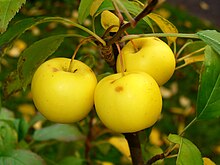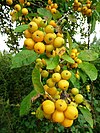Malus sylvestris
| Malus sylvestris | |
|---|---|

| |
| Scientific classification | |
| Kingdom: | Plantae |
| Clade: | Tracheophytes |
| Clade: | Angiosperms |
| Clade: | Eudicots |
| Clade: | Rosids |
| Order: | Rosales |
| Family: | Rosaceae |
| Genus: | Malus |
| Species: | M. sylvestris
|
| Binomial name | |
| Malus sylvestris | |
Malus sylvestris, the European crab apple, also known as the European wild apple or simply the crab apple, is a species of the genus Malus, native to Europe and western Asia. Its scientific name means "forest apple".
Description and identification
[edit]The wild apple is a deciduous small to medium-sized tree, but can also grow into a multi-stemmed bush. It can live 80–100 years and grow up to 14 metres (46 feet) tall with trunk diameters of usually 23–45 centimetres (9–17+1⁄2 inches), although diameters exceeding 90 centimetres (35 in) have been recorded.[2] The leaves are roundish-oval and sometimes hairy on the underside. The hermaphrodite flowers appear in May, slightly preceding hawthorn, have white or pinkish petals and are insect-pollinated. The small pome-fruits are around 3 centimetres (1.2 in) in diameter, ripen in autumn and fall to the ground. The bark is light brown and breaks up in flakes.[2] The branches are thorny, especially in response to pruning or browsing.
European wild apples hybridise readily with domesticated apples. This can make identification difficult, as hybrids commonly exhibit traits that are transitional with respect to the two parent species. Generally, a reliable identification cannot be made without genetic testing, however, there are clues that can help identify individuals that are likely to be pure wild apples. Wild apple leaves tend to be somewhat smaller, stiffer and shinier. In comparison to those of both domesticated and hybrid apples, the underside of wild apple leaves also tends to be less hairy, often lacking hairs altogether. The crown of wild apples is also densely branched, whereas the crown of domesticated apples tends to be more loosely arranged with fewer, straighter branches. Finally, wild apple fruits tend to be smaller. The apples are usually below the threshold of 3 centimetres (1.2 in) in diameter, while domesticated and hybrid apples tend to be above. None of these features is entirely conclusive, however, and the best field identification results from their combined utilization.[2]
Distribution and habitat
[edit]The tree is widespread throughout Europe, with the exception of the extreme north and south. Additionally, it is also distributed in Anatolia and further into the south Caucasus.[2] However, it occurs in a scattered distribution pattern as single individuals or in small groups.[3] Due to its weak competitiveness and high light requirement, the wild apple is found mostly at sites where competition is reduced, such as the wet edge of forests, in wood pasture, farmland hedges or on very extreme, marginal sites.[3] In the British Isles it occurs throughout Ireland, England and Wales and with reduced frequency in Scotland.[2] In Scotland, it is most commonly found in woodlands and wood pastures.[2]
Progenitor of cultivated apples
[edit]In the past M. sylvestris was thought to be the most important ancestor of the cultivated apple (M. domestica), which has since been shown to have been primarily derived from the central Asian species M. sieversii.[4] However, DNA analyses confirm that M. sylvestris has contributed significantly to the genome.[5][6] They found that secondary introgression from other species of the genus Malus has greatly shaped the genome of M. domestica, with M. sylvestris being the largest secondary contributor. They also found that current populations of M. domestica are more closely related to M. sylvestris than to M. sieversii. However, in more pure strains of M. domestica, the M. sieversii ancestry still predominates.[citation needed]
Ecology and threats
[edit]
The European wild apple is dispersed primarily by mammals, which eat the fruits. In a study from Mols, Denmark, it was determined that cattle accounted for the bulk of dispersal, followed by horses, despite the presence of wild animals.[7] In Britain, the crab apple is associated with 93 species of insect.[8] Its leaves are food of the hawthorn moth (Scythropia crataegella).[citation needed]
Throughout its range, the wild apple is threatened and rare.[3] Threats include the introgression from domesticated apples, the lack of natural regeneration and modern forestry practice, which promotes the closure of forest canopy cover, as opposed to the formerly prevailing coppice.[9][10] In many aspects, the wild apple exhibits adaptations to grazing and the presence of large herbivores, and consequently also a high degree of dependence on them.[7][9] It is thorny, suitable for coppice due to pronounced resprouting abilities and a very hardy tree. Wild apples may survive crown collapse and the breakage of major branches.[2] In dispersal, it appears to be strongly reliant on bovines and equines. Since the extinction of both wild horses and aurochsen, and the near-extinction of the European bison, domesticated livestock seems to have assumed this role and replaced their extinct relatives.[7][11] With the abolition of traditional pasturage in town commons beginning in the 16th century, however, and the rearing of livestock in factory farms as a consequence of agricultural intensification, these large herbivores are now largely absent from the landscape. Additionally, while research indicates the widespread existence of half-open savanna ecosystems during Europe's prehistory, shaped and maintained by megafauna,[12][13] this is no more the case. Nowadays, the landscape in many parts of Europe is marked by closed-canopy forest, often intensively managed, coupled with agricultural fields and urban spaces, with little else and few transitional zones such as mantle and fringe vegetation.[14] As a result, European wild apple today lacks both suitable habitats and dispersal opportunities, resulting in a lack of successful regeneration.
Genetics and postglacial recolonization
[edit]Like most European tree species, the distribution of the European wild apple was limited to refugia in southern Europe during the last glacial period. For the European wild apple, these refugia seem to have constituted southern France and northern Spain, the Balkans and possibly the Carpathians, respectively.[15] From there, it recolonized the rest of Europe following the glacial retreat at the onset of the Holocene, and the colonization paths find themselves reflected in its modern distribution and genetic structure. Again as in many other organisms in Europe, plants and animals alike, the population of the European wild apple is divided into a large western population and a more strongly differentiated eastern population. Western Europe and northern Europe were most likely colonized from southern France, while eastern Europe was colonized from the Carpathians. In the process, some admixture between both populations seems to have occurred as they met.[15]
Gallery
[edit]-
Ripe crab apples on the branch
-
Bark
-
Flowers
-
Mature tree
-
Ancient tree
-
Ripe fruit on the ground
See also
[edit]- Wood-pasture hypothesis
- Pleistocene megafauna
- Pyrus pyraster
- Malus orientalis
- Malus trilobata
- Malus florentina
References
[edit]- ^ "Malus sylvestris (Crab Apple, European Crab Apple, Pommier Sauvage)". Iucnredlist.org. 2010-04-16. Retrieved 2018-09-21.
- ^ a b c d e f g Worrel, Rick; Ruhsam, Markus; Renny, James; Jessop, Will; Findlay, Graeme (2018): "The Ecology and Genetics of Scotland's native wild apple: Malus sylvestris"
- ^ a b c Stephan, B.R.; Wagner, I. & Kleinschmit, J. (2003), Wild apple and pear - Malus sylvestris/Pyrus pyraster: Technical guidelines of genetic conservation and use (PDF), European Forest Genetic Resources Programme, archived from the original (PDF) on 2016-10-20, retrieved 2016-10-20
- ^ Velasco R., Zharkikh A., Affourtit J. et al., The genome of the domesticated apple (Malus × domestica Borkh.) Nature Genetics, 2010, 42, 10, 833
- ^ Coart, E., Van Glabeke, S., De Loose, M., Larsen, A.S., Roldán-Ruiz, I. 2006. Chloroplast diversity in the genus Malus: new insights into the relationship between the European wild apple (Malus sylvestris (L.) Mill.) and the domesticated apple (Malus domestica Borkh.). Mol. Ecol. 15 (8): 2171-82.
- ^ Cornille, Amandine; Gladieux, Pierre; Smulders, Marinus J. M.; Roldán-Ruiz, Isabel; Laurens, François; Cam, Bruno Le; Nersesyan, Anush; Clavel, Joanne; Olonova, Marina; Feugey, Laurence; Gabrielyan, Ivan; Zhang, Xiu-Guo; Tenaillon, Maud I.; Giraud, Tatiana (2012-05-10). "New Insight into the History of Domesticated Apple: Secondary Contribution of the European Wild Apple to the Genome of Cultivated Varieties". PLOS Genetics. 8 (5): e1002703. doi:10.1371/journal.pgen.1002703. ISSN 1553-7404. PMC 3349737. PMID 22589740.
- ^ a b c Buttenschøn, Rita Merete; Buttenschøn, Jon (1998). "Population dynamics of Malus sylvestris stands in grazed and ungrazed, semi-natural grasslands and fragmented woodlands in Mols Bjerge, Denmark". Annales Botanici Fennici. 35 (4): 233–246. ISSN 0003-3847. JSTOR 23726629.
- ^ "The value of different tree species for insects and lichens". www.countrysideinfo.co.uk. Retrieved 2023-10-21.
- ^ a b Ulrike Hoffmann: Wildäpfel im Spannungsfeld menschlichen Wirtschaftens. Natur in NRW 2/2018: 17-21. (In German)
- ^ Wagner, Iris; Maurer, W. D.; Lemmen, P.; Schmitt, H. P.; Wagner, M.; Binder, M.; Patzak, P. (2014-12-01). "Hybridization and Genetic Diversity in Wild Apple (Malus sylvestris (L.) MILL.) from Various Regions in Germany and from Luxembourg". Silvae Genetica. 63 (1–6): 81–93. doi:10.1515/sg-2014-0012. S2CID 85629669.
- ^ Bruun, Hans Henrik; Fritzbøger, Bo (August 2002). "The Past Impact of Livestock Husbandry on Dispersal of Plant Seeds in the Landscape of Denmark". AMBIO: A Journal of the Human Environment. 31 (5): 425–431. Bibcode:2002Ambio..31..425B. doi:10.1579/0044-7447-31.5.425. ISSN 0044-7447. PMID 12374051. S2CID 28807421.
- ^ Sandom, Christopher J.; Ejrnæs, Rasmus; Hansen, Morten D. D.; Svenning, Jens-Christian (2014-03-18). "High herbivore density associated with vegetation diversity in interglacial ecosystems". Proceedings of the National Academy of Sciences. 111 (11): 4162–4167. Bibcode:2014PNAS..111.4162S. doi:10.1073/pnas.1311014111. ISSN 0027-8424. PMC 3964052. PMID 24591633.
- ^ Pearce, Elena A.; Mazier, Florence; Normand, Signe; Fyfe, Ralph; Andrieu, Valérie; Bakels, Corrie; Balwierz, Zofia; Bińka, Krzysztof; Boreham, Steve; Borisova, Olga K.; Brostrom, Anna; de Beaulieu, Jacques-Louis; Gao, Cunhai; González-Sampériz, Penélope; Granoszewski, Wojciech (2023-11-10). "Substantial light woodland and open vegetation characterized the temperate forest biome before Homo sapiens". Science Advances. 9 (45): eadi9135. Bibcode:2023SciA....9I9135P. doi:10.1126/sciadv.adi9135. ISSN 2375-2548. PMC 10637746. PMID 37948521.
- ^ Bobiec, Andrzej; Reif, Albert; Öllerer, Kinga (2018-04-01). "Seeing the oakscape beyond the forest: a landscape approach to the oak regeneration in Europe". Landscape Ecology. 33 (4): 513–528. Bibcode:2018LaEco..33..513B. doi:10.1007/s10980-018-0619-y. ISSN 1572-9761. S2CID 254746665.
- ^ a b Cornille, A.; Giraud, T.; Bellard, C.; Tellier, A.; Le Cam, B.; Smulders, M. J. M.; Kleinschmit, J.; Roldan-Ruiz, I.; Gladieux, P. (April 2013). "Postglacial recolonization history of the European crabapple ( Malus sylvestris M ill.), a wild contributor to the domesticated apple". Molecular Ecology. 22 (8): 2249–2263. Bibcode:2013MolEc..22.2249C. doi:10.1111/mec.12231. ISSN 0962-1083. PMID 23402276. S2CID 9097189.
Further reading
[edit]- M.H.A. Hoffman, List of names of woody plants, Applied Plant Research, Boskoop 2005.
- RHS dictionary of gardening, 1992
External links
[edit]- USDA Plants Profile for Malus sylvestris
- Jepson Manual (JM93) treatment of Malus sylvestris — introduced species in California.
- Malus sylvestris in the CalPhotos photo database, University of California, Berkeley
- EUFORGEN species page: Malus sylvestris. Information, distribution and related resources.








